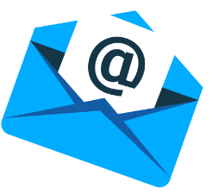Email marketing is a valuable tactic in today's business world. It can reach a wide range of consumers, generate leads, and provide an exceptional ROI for brands that use it properly. Of course, email marketing is not the kind of thing a business should plunge into without some preparation.
Let's discuss six key things every business should do before launching an email marketing strategy.
1. Know Your Target Customer
 First, it's vital to understand exactly who you want to target with your marketing emails and why they want to buy from your brand. For example: are you a B2C company offering unsurpassed products? Then you'll likely want to target customers willing to pay more for a premium offering. Are you a B2B brand with years of experience in the industry? Then you may want to pursue prospects who need expert assistance.
First, it's vital to understand exactly who you want to target with your marketing emails and why they want to buy from your brand. For example: are you a B2C company offering unsurpassed products? Then you'll likely want to target customers willing to pay more for a premium offering. Are you a B2B brand with years of experience in the industry? Then you may want to pursue prospects who need expert assistance.
Whatever the case, the point is to know your target customer first so that you can craft emails that will genuinely resonate with them.
2. Start Lead Generation to Build Your Email List
 Unless you're going to "cold email" a bunch of people (not a good idea), you'll need a list of qualified contacts for your email marketing campaign. The best way to collect these contacts is to have consumers actively opt into your mailing list — which usually requires lead magnets, such as downloadable white papers, blogs, and social media posts.
Unless you're going to "cold email" a bunch of people (not a good idea), you'll need a list of qualified contacts for your email marketing campaign. The best way to collect these contacts is to have consumers actively opt into your mailing list — which usually requires lead magnets, such as downloadable white papers, blogs, and social media posts.
Use whatever resources you have at your disposal to encourage sign-ups, and start building a fantastic email list!
3. Craft Compelling Emails
 These, of course, are the "meat" of any email marketing campaign. You must develop emails that provide real value to customers so they'll stay subscribed to your list and hopefully progress through the sales funnel. For example, a regular B2B newsletter highlighting recent changes and trends in the target industry can offer contacts a wealth of helpful insights.
These, of course, are the "meat" of any email marketing campaign. You must develop emails that provide real value to customers so they'll stay subscribed to your list and hopefully progress through the sales funnel. For example, a regular B2B newsletter highlighting recent changes and trends in the target industry can offer contacts a wealth of helpful insights.
In addition, don't neglect the subject line! Many subscribers will only open your email if the subject line interests them. Work to create clear, concise, punchy subject lines that appeal to your audience.
4. Stay Compliant with Regulations and Best Practices
 It's important to realize that periodic "cleansing" of your email list will be necessary for optimal results. For instance, if recipients have unsubscribed or email addresses are no longer valid, you should remove them from your database.
It's important to realize that periodic "cleansing" of your email list will be necessary for optimal results. For instance, if recipients have unsubscribed or email addresses are no longer valid, you should remove them from your database.
This type of regular maintenance is essential regarding spam regulations. You don't want your brand to develop a reputation as a spammer, which could hinder emails to legitimate contacts from going through. This is mostly the best practice to keep your email marketing tools in good health and ensure that your emails go to active addresses.
5. Test for Constant Improvement
 You'll need to continue evaluating your email marketing strategy to see where to improve it. Even if your emails are performing well, there will always be opportunities to optimize your open and click-through rates.
You'll need to continue evaluating your email marketing strategy to see where to improve it. Even if your emails are performing well, there will always be opportunities to optimize your open and click-through rates.
A/B testing is one of the most common ways you can test the performance of your email marketing campaign. For example, you can create two slightly different emails that cover the same topic and send each to a different half of your contact list. Then, determine which one gains higher open and click-through rates. You can A/B test several aspects of your email marketing strategy, such as:
- When to send emails for the best results
- Which subject lines to use
- Whether to incorporate emojis into your subject line and body
6. Determine KPIs to Analyze Results
 Set up your key performance indicators (KPIs) at the very outset of your email marketing campaign to get total, accurate results. By doing so, you can take the data you collect about who opens your emails and how they interact with them and use it to evaluate your campaign results accurately. After all, if you can't measure it to know how it performs, you can't improve your efforts.
Set up your key performance indicators (KPIs) at the very outset of your email marketing campaign to get total, accurate results. By doing so, you can take the data you collect about who opens your emails and how they interact with them and use it to evaluate your campaign results accurately. After all, if you can't measure it to know how it performs, you can't improve your efforts.
Lay the Groundwork for a Successful Email Marketing Campaign
Email marketing is an excellent tool for driving engagement, generating leads, and converting prospects into customers. At the same time, an email marketing campaign must be developed and executed with intentionality and focus. If you know your audience well, invest in lead generation, craft compelling emails, regularly clean your contact list, A/B test different aspects of your strategy and use the right KPIs. You'll be well on your way to deploying a highly effective campaign.
If you need some help from a team of highly trained and experienced marketing professionals, look no further than our team at McClatchy. We have helped scores of clients develop and execute winning email marketing campaigns and meet their business goals — whether they involved more engagement, more leads, or more sales. Reach out today to begin the conversation!





